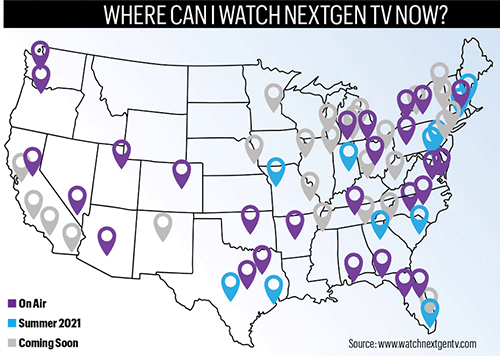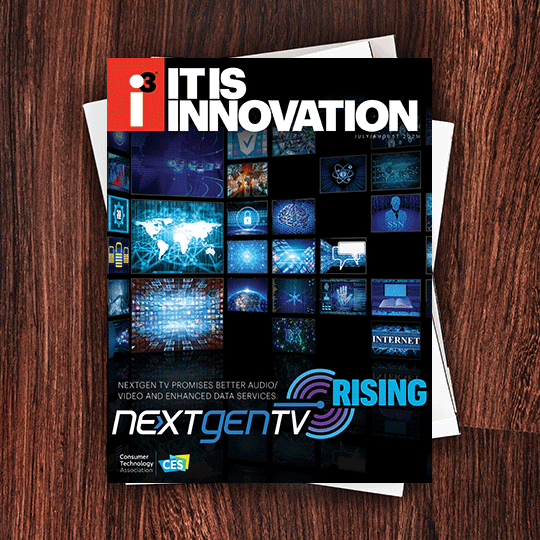LG has focused on the premium segment, marrying the superior performance of LG OLED and the new features unlocked by ATSC 3.0.John Taylor of LGE
Moreover, the TV owners involved in NEXTGEN TV rollouts are buoyed by responses to a Magid research study this spring in which 60% of TV viewers said they’d buy the new 3.0 technology within three years of its availability. And the broadcasters are looking forward to a showcase rollout in Washington, D.C., scheduled for late summer — an “all-encompassing effort” that will include most local stations, the National Association of Broadcasters, Howard University (licensee of a public TV channel) plus the Pearl TV consortium and Sinclair Broadcasting Group — two of the major promoters of NEXTGEN TV.
In short, a lot has happened since the Federal Communications Commission (FCC) authorized broadcasters to voluntarily launch Internet Protocol-based advanced television services in November 2017, which was followed by the Advanced Television Systems Committee’s final adoption of its ATSC 3.0 standard in September 2019. The “NEXTGEN TV” brand emerged at the same time.
“Based on early feedback from consumers and from broadcasters’ research, viewers are excited about NEXTGEN TV,” says Brian Markwalter, CTA’s senior vice president of research and standards. “They particularly like the enhanced and interactive content provided by ATSC 3.0 integration of broadcast and IP services, which gives them additional content information, on-demand video and premium viewing experiences with 4K UHD and HDR.”
Markwalter also cites positive response to the immersive audio and especially “the unique capability called Voice + that lets you hear the dialog very clearly.” He expects that after absorbing the “enhanced live programming” that NEXTGEN TV delivers, consumers will enjoy discovering “the additional benefits of interactivity and upgradeability.”
CTA expects that converter boxes (set-top devices that will enable existing TV sets to receive and display Next Gen TV signals) will accelerate adoption, although they will play a different role than the converter boxes did during the transition from analog to digital TV in the early 2000s. This time there will be no government subsidized vouchers and no hard cut-off date for the old technology, so the migration schedule to NEXTGEN TV is still a little fuzzy.
But the improved all-Internet Protocol signal — including its audio and data flexibility — is strong. Hence companies in the 3.0 ecosystem are counting on rapid adoption. NEXTGEN TV broadcasts can deliver 4K Ultra HD video quality, HDR displays, theater-like sound and expanded mobile reception.
CTA’s forecast expects NEXTGEN TV sets will account for 9% of TV sets shipped next year, climbing to 47% by 2024. That equates to four million units in 2022, 11 million in 2023 and 20 million in 2024.
Sony has plunged into the NEXTGEN TV world wholeheartedly. Almost every TV set (40 models) it sells in the U.S. this year will be able to receive the ATSC 3.0 signal, says Nick Colsey, vice president of business development at Sony Electronics.
In addition to its line of NEXTGEN TV receivers, Sony has been involved in most of the field trials during recent years and its engineers have worked on the technical definitions and test of the standard. Another Sony group makes 3.0 semiconductors that are used in Sony and other brands’ TV receivers. Sony is also participating in the “Motown 3.0 Test Track” automotive project in Detroit, using a tuner/demodulator which is optimized for mobile use case, Colsey adds.
LG Electronics USA has been involved throughout the 3.0 evolution. As a co-inventor of the standard, it has been collaborating with broadcasters during the development process and was the first manufacturer to supply equipment for the Phoenix pilot market trial, explains LGE Senior Vice President John Taylor. Since the company has also had mobile and automotive units, it has leveraged its capabilities “as a key technology partner” in the Motown 3.0 Test Track project, he adds, focusing on opportunities for telematics and navigation updates, software upgrades, sensors and infotainment.
Taylor says that LG has “focused on the premium segment, marrying the superior performance of LG OLED and the new features unlocked by ATSC 3.0.” Among its video devices being used in rollouts are 4K and 8K OLED NEXTGEN TVs ranging from 55- to 88-inches. “As the number of stations offering NEXTGEN TV service grows, we anticipate strong growth for ATSC 3.0 receivers,” Taylor says. “Despite the pandemic effect, the uptake of NEXTGEN TV broadcasting in the U.S. over the past year has been nothing short of phenomenal.”
As we look at it, there will be applications that are seamless between cable and over-the-air TV, such as sports betting and shopping.Anne Schelle of Pearl TV
“We have to think about this in stages with the cable companies,” Schelle explains. “We’re working through the different technical aspects of integration including ecosystem support.” The results of that process will “allow the business folk to have discussions when the time is right around business issues.”
Schelle says the tests so far have generated valuable information for future technical integration of ATSC 3.0 signals via cable. She adds that Pearl TV is “discussing the technical integration considerations” with CableLabs, Comcast, Cox and other large MSOs for future implementations of NEXTGEN TV via cable.
Among the services that are being evaluated are formatted video and High Dynamic Range (HDR) video, a key feature in 4K Ultra HD television. The seven Portland TV stations will also add data applications to the technical trial.
“There is value in these applications, such as emergency alerts, multilingual service and rich-media alerting,” Schelle says, emphasizing the potential enhancement for cable customers. “As we look at it, there will be applications that are seamless between cable and over-the-air TV, such as sports betting and shopping.” She describes a NEXTGEN platform, now in development, that includes a framework for “enhancing content” for various interactive features.
Schelle says the NEXTGEN platform will enable “opening up layers to applications developers.” This “framework for enhancing content” has not been part of the Portland trial, which has focused until now strictly on technical factors.
Among other new ventures are the “EVOCA” pay TV service for ATSC 3.0, developed by Edge Networks and aimed at offering a rural market alternative to cable TV and satellite video. Edge Networks CEO Todd Achilles introduced the NEXTGEN TV service in his company’s hometown Boise, ID, last year and is rolling it into Phoenix, AZ. Evoca is already in the market with a receiver that receives “in the clear” ATSC 3.0 signals as well as encrypted channels via broadcast and internet sources.
Evoca TV, which calls itself an “OTA-OTT” [over-the-air/over-the-top] hybrid pay TV service has begun transmitting “Evoca Learn,” a free ATSC 3.0 programming service, and a Basque-language channel to reach the Basque community (about 15,000 people) in Boise, using programming from a Basque channel in Spain. The educational service will feature interactivity, such as quizzes to gauge what they’ve learned and keep them engaged, Achilles explains.
With as many as 60 markets potentially coming online in the U.S. in 2021 according to ATSC, as many as 70% of all American viewers could benefit from ATSC 3.0 services.
To keep track of the fast-evolving world of NEXTGEN TV, check out these online resources from major players in the migration to ATSC 3.0.

For up-to-date information on NextGen TV availability.

I3, the flagship magazine from the Consumer Technology Association (CTA)®, focuses on innovation in technology, policy and business as well as the entrepreneurs, industry leaders and startups that grow the consumer technology industry. Subscriptions to i3 are available free to qualified participants in the consumer electronics industry.